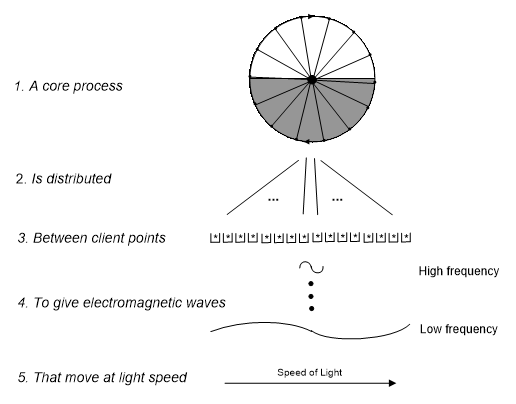Processing systems need fundamental processes as particle systems need fundamental particles. Every CPU has a set of fundamental processes called its instruction set. For example, if “add one” is fundamental, it adds a hundred by adding one a hundred times. As computing evolved to include databases and networks, the instruction set got bigger, so it was called Complex Instruction Set Computing (CISC). Then it was realized that fewer instructions are better because they run faster and there is less to go wrong, giving Reduced Instruction Set Computing (RISC). The ultimate RISC design is one process that does everything, and the quantum network instruction set seems to be just that, based on the process:
Set the next value in a circle
This process, to set values in a circle, is now proposed to underlie space and light. It is reliable because each cycle ends where it began, ready to run again. If it runs at one point, the positive and negative values cancel to give a null result that can be space. If it runs at many points, it can be light. One fundamental process can then represent space or light depending on whether it runs at one point (space), or is distributed over many points (light).
In quantum theory, quantum waves spread at the speed of light but collapse to restart at a point when observed. The quantum model explains this odd behavior as processing waves spreading on a network, generated by a server that can restart them as needed. Figure 3.11 then shows how one process can generate the entire electro-magnetic spectrum, depending on how it is distributed.
Distributing a process over many points runs it slower, just as dividing a workforce makes a job take longer to finish. A photon quantum wave can then be one process distributed over its wavelength points. Distributing it less gives short wavelength light that runs faster; while distributing it more gives long wavelength light that runs slower. Light then, in all its forms, can arise from one process distributed more or less, spreading on the quantum network. Note that this process isn’t physical, it just sets values as complex number theory says.

In Figure 3.11, one core process (1), distributed (2) more or less between client points (3), can give electro-magnetic waves (4), that are passed on at the speed of light (5). The rotation process spreads as a sine wave, and can divide more or less to give any light wave length. Shorter wave lengths make each point run faster, while longer wave lengths make each point run slower.
As the process spreads, new points begin the process, but as they start, those at the rear are finishing. Each network cycle, the wave spreads to new points, leaving those behind to run to completion. As new points begin, others finish, so the total server demand per photon stays the same. Every photon in the electro-magnetic spectrum, whether a radio wave or an X-ray, is then the same process distributed more or less. This process is also the null process of space, so light is, in effect, space on the move.
This fundamental process is now called a Planck process, because it is the smallest activity of the quantum network, just Planck energy is the smallest activity of our world.